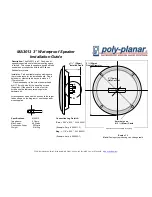
Marine Installation Manual
2022-03
6-8
6 Engine Dynamics
6.2 External lateral forces and moments
X62DF-S2.0
6.2.2
Reduction of lateral vibration
The amplitudes of the vibrations transmitted to the hull depend on the design of
the engine seating, frame stiffness and exhaust pipe connections. As the ampli
-
tude of the vibrations cannot be predicted with absolute accuracy, the support to
the ship’s structure and the space required to install the stays must be considered
in the early design stages of the engine room structure. This is true for both lat
-
eral and longitudinal vibrations, which are further discussed along with relative
reduction methods in the subsections that follow.
Lateral stays
If required, lateral stays (i.e. stays in the lateral direction) must be fitted between
the upper engine platform and the ship hull to prevent harmful resonance condi
-
tions. The main function of lateral stays is to shift the resonance frequency suffi
-
ciently above nominal speed as shown in
Figure 6
-
6 Lateral stays shifting the resonance frequency above nominal speed
In addition, if hydraulic type stays are installed, as requested by WinGD, then a
damping effect is provided by these stays.
NOTE
WinGD recommends a stiff engine foundation design in the longitudinal
and lateral directions, as this is always best practice in minimising hull
vibrations.
NOTE
If lateral stays are required, WinGD requests installation of hydraulic
type stays. These are available from third-party suppliers.
SM-0794
n
CMCR
n [rpm]
V
ibration amplitude
without lateral stays
with lateral stays
















































